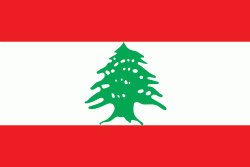Bhamdoun (Bhamdoûn el Mhatta)
Bhamdoun (بحمدون), is a town in Lebanon 23 km from Beirut on the main road that leads to Damascus and in the suburbs of the main tourist city of Aley, lying at an altitude of 1150 m above the Lamartine valley. Two separate villages compose the town, Bhamdoun-el-mhatta (literally meaning "Bhamdoun the station") and Bhamdoun-el-day'aa ("Bhamdoun the village"). A railroad used to link Bhamdoun to Beirut with the train station being a prominent feature of the town for many years. The station and railroad were eventually abandoned when cars became more popular.
Before the Lebanese civil war, Bhamdoun was one of Lebanon's most renowned and favorite summer resorts. Today, the town has regained some of its past tourism industry as most of its hotels, restaurants and entertainment centers have been renovated or rebuilt. Tourists, especially from Kuwait and the Persian Gulf region spend their summer vacation in Bhamdoun. Kuwaiti citizens own more than 30% of the properties in Bhamdoun Station since the 1950s. A branch of Kuwait airways and the National bank of kuwait reopened in 2001.
Bhamdoun has seven churches, two mosques built by Kuwaitis, and the Bhamdoun synagogue. There are four Greek Orthodox churches, two Maronite, one Protestant but was not reconstructed after the war, and Druze Khalwa. Most of the population is Orthodox Christian, but there also is a large Druze and Maronite minority with a smaller Sunni Muslim one.
The Bhamdoun synagogue, built in 1910, was one of three grand synagogues in Lebanon. It was abandoned shortly before the civil war which started in 1975, but the shell of the structure still stands.
In 2000, a winery called Chateau Belle-Vue began planting vines, creating few jobs in the village. It began producing wine in 2003. The "Renaissance 2003" blend that it produced won the International Spirits and Wine Competition's Gold Medal Best in Class award in 2005. The town also contains the Safir Hotel, Four Points Hotel by Sheraton, Carlton Hotel, Alsheikh Hotel and many others.
Families who have roots in Bhamdoun are:
* Khairallah (also Cairala, Khairalla, Khiralla, Jairala, Kyrala, Kheirallah or Khayrallah)
* Abdel Nour
* Haddad (Also spelled Al Haddad)
* Abou Rjeili (also spelled Bou Rjayle)
Before the Lebanese civil war, Bhamdoun was one of Lebanon's most renowned and favorite summer resorts. Today, the town has regained some of its past tourism industry as most of its hotels, restaurants and entertainment centers have been renovated or rebuilt. Tourists, especially from Kuwait and the Persian Gulf region spend their summer vacation in Bhamdoun. Kuwaiti citizens own more than 30% of the properties in Bhamdoun Station since the 1950s. A branch of Kuwait airways and the National bank of kuwait reopened in 2001.
Bhamdoun has seven churches, two mosques built by Kuwaitis, and the Bhamdoun synagogue. There are four Greek Orthodox churches, two Maronite, one Protestant but was not reconstructed after the war, and Druze Khalwa. Most of the population is Orthodox Christian, but there also is a large Druze and Maronite minority with a smaller Sunni Muslim one.
The Bhamdoun synagogue, built in 1910, was one of three grand synagogues in Lebanon. It was abandoned shortly before the civil war which started in 1975, but the shell of the structure still stands.
In 2000, a winery called Chateau Belle-Vue began planting vines, creating few jobs in the village. It began producing wine in 2003. The "Renaissance 2003" blend that it produced won the International Spirits and Wine Competition's Gold Medal Best in Class award in 2005. The town also contains the Safir Hotel, Four Points Hotel by Sheraton, Carlton Hotel, Alsheikh Hotel and many others.
Families who have roots in Bhamdoun are:
* Khairallah (also Cairala, Khairalla, Khiralla, Jairala, Kyrala, Kheirallah or Khayrallah)
* Abdel Nour
* Haddad (Also spelled Al Haddad)
* Abou Rjeili (also spelled Bou Rjayle)
Map - Bhamdoun (Bhamdoûn el Mhatta)
Map
Country - Lebanon
 |
 |
| Flag of Lebanon | |
The earliest evidence of civilization in Lebanon dates back to 5,000 BCE. From c. 3200–539 BC, it was home to the flourishing Phoenician civilization before being annexed by various Near Eastern empires. In 64 BC, the Roman Empire conquered the region, and the region became a major center for Christianity under the Byzantine Empire. In the 7th century, the Muslim conquest of the Levant established caliphal rule. The 11th century saw the start of the Crusades and the establishment of Crusader States in the region only for it to be later reclaimed by the Ayyubids and Mamluks before being ceded to the Ottoman Empire in the 16th century. Under Sultan Abdulmejid I, the first Lebanese protostate took form in the 19th century as the Mount Lebanon Mutasarrifate, created as a home for the Maronite Christians under the Tanzimat reforms.
Currency / Language
| ISO | Currency | Symbol | Significant figures |
|---|---|---|---|
| LBP | Lebanese pound | لل | 2 |
| ISO | Language |
|---|---|
| AR | Arabic language |
| HY | Armenian language |
| EN | English language |
| FR | French language |















